Wednesday, April 25, 2012
Thursday, April 12, 2012
TRAVEL AND BAKING IMPRESSIONS
Warnemünde is not only the harbor for Hansetown Rostock, but
a graceful old Baltic Sea resort. Thanks to the former GDR's lack of
money, none of the nice old houses was torn down to make place to modern
nondescript highrise hotels, like in West Germany.
When I first visited my cousin's family in 1957, houses were grey, with flaking paint, looking more and more dilapidated every year. That changed dramatically after the fall of the wall and the reunion 1989. All houses were fixed-up, by and by.

The yacht pier, exclusively used by communistic party VIPs, was opened to the public, and turned into a fish market.

Lots of smoke shacks on the pier (I never saw so many kinds of smoked fish before), and they even had an open air bakery.

Those naughty boys on the bakery sign are Max and Moritz - characters from the classic German childrens' book. After sneaking into a bakery, camouflaging themselves with dough, they survive being mistaken for breads and consequently baked.
Eating their way out, and hiding in flour bags, they get nabbed, and their long and successful career as juvenile delinquents ends as - kibbles for miller's geese!

Bakery at the fish market with freshly baked potato carrot breads, in a wood fired oven.
In one of the many waterfront restaurants we had "all-you-can-eat" herring. You can't buy them in Maine, though there are plenty - they all end up at bait for the lobster traps. Much as I like lobster, nothing compares to fresh, pan fried herring with bratkartoffeln.
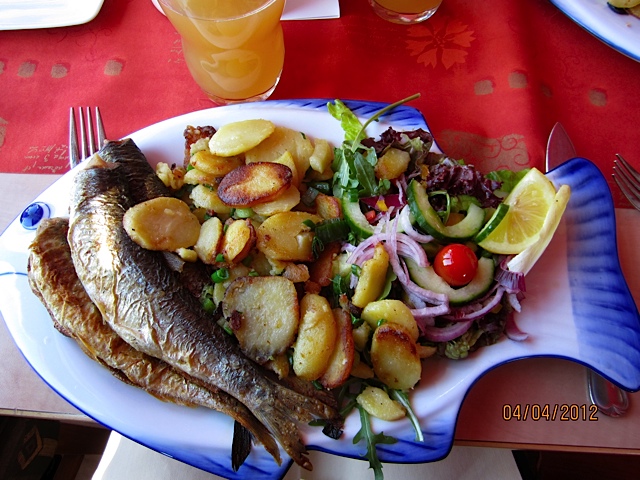
Easter was cold but sunny, we walked along the Alster - a large, artificial lake in the middle of Hamburg.

We had family dinner overlooking the harbor, where paddle wheel boat "Louisiana" passed by.

On our way back, at Hamburg Airport, we had time for breakfast and were utterly amazed to find this:
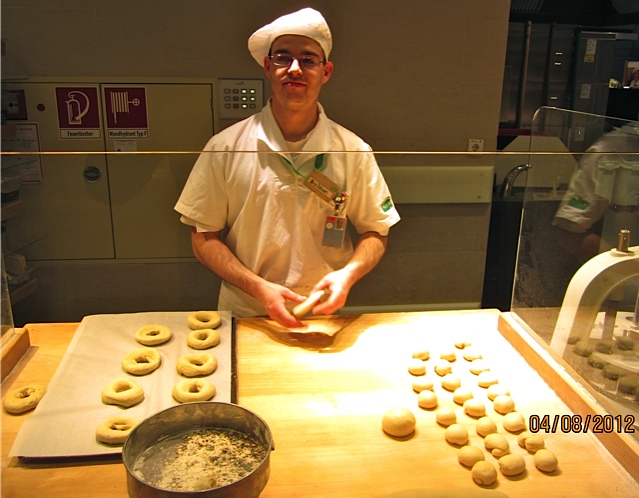
A bakery that made everything from the scratch, from organic ingredients, right in Terminal 1!
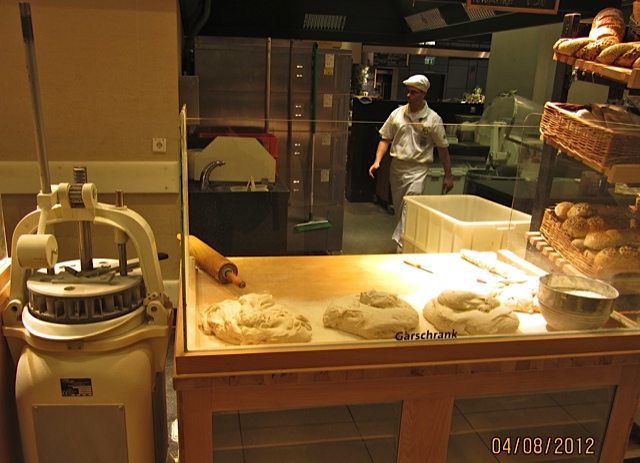
On the left is a dough divider (for rolls), the glass box is a proofing cabinet.
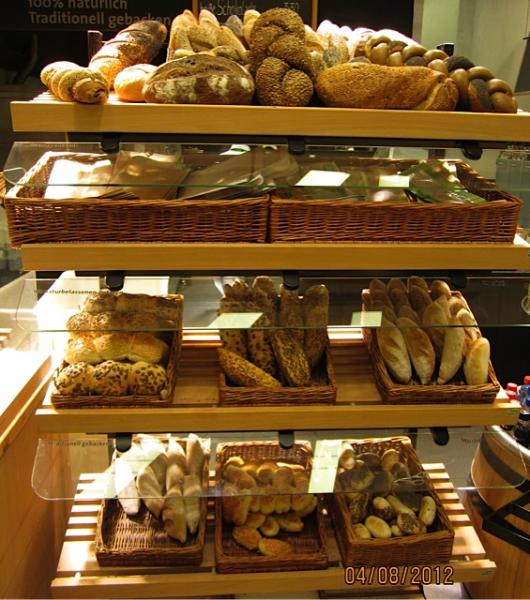
"Marché Bakery" offers a large selection of breads and pastries. I chose this roll with a twist:
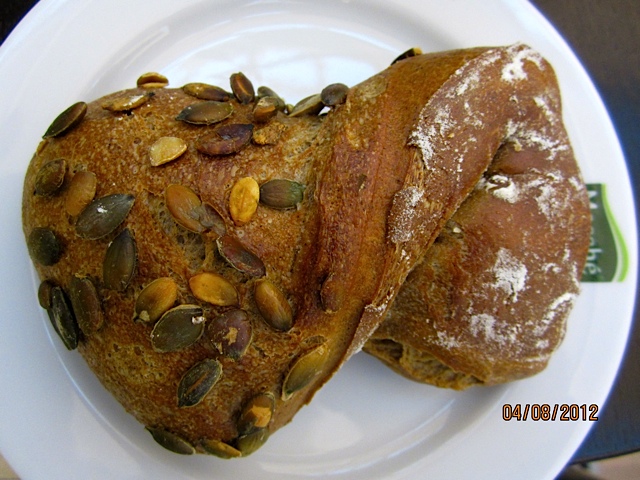
It was as good as it looked like! The best breakfast I ever had in an airport.
When I first visited my cousin's family in 1957, houses were grey, with flaking paint, looking more and more dilapidated every year. That changed dramatically after the fall of the wall and the reunion 1989. All houses were fixed-up, by and by.

The yacht pier, exclusively used by communistic party VIPs, was opened to the public, and turned into a fish market.

Lots of smoke shacks on the pier (I never saw so many kinds of smoked fish before), and they even had an open air bakery.

Those naughty boys on the bakery sign are Max and Moritz - characters from the classic German childrens' book. After sneaking into a bakery, camouflaging themselves with dough, they survive being mistaken for breads and consequently baked.
Eating their way out, and hiding in flour bags, they get nabbed, and their long and successful career as juvenile delinquents ends as - kibbles for miller's geese!

Bakery at the fish market with freshly baked potato carrot breads, in a wood fired oven.
In one of the many waterfront restaurants we had "all-you-can-eat" herring. You can't buy them in Maine, though there are plenty - they all end up at bait for the lobster traps. Much as I like lobster, nothing compares to fresh, pan fried herring with bratkartoffeln.

Easter was cold but sunny, we walked along the Alster - a large, artificial lake in the middle of Hamburg.

We had family dinner overlooking the harbor, where paddle wheel boat "Louisiana" passed by.

On our way back, at Hamburg Airport, we had time for breakfast and were utterly amazed to find this:

A bakery that made everything from the scratch, from organic ingredients, right in Terminal 1!

On the left is a dough divider (for rolls), the glass box is a proofing cabinet.

"Marché Bakery" offers a large selection of breads and pastries. I chose this roll with a twist:

It was as good as it looked like! The best breakfast I ever had in an airport.
Tuesday, April 3, 2012
POPPY SEED DINNER ROLLS
Hier geht's zur deutschen Version dieses Posts
A great fan of crusty breads, I'm normally no friend of dinner rolls. I had them sometimes in restaurants, soft, bland and usually so pale that they seemed almost under-baked.
I could never really understand why anybody would prefer to eat these fluff balls with their dinner instead of a nice crispy baguette.
But, fortunately, my baking friend Hanaâ prompted me (again) to overcome my bias against seemingly weird American predilections - with the Buttery Pull-Apart Dinner Rolls from Abigail Dodge's "The Weekend Baker".
What I like about the book are its practical make-ahead instructions. Being convinced that even enriched doughs benefit from long fermentation, I followed Abby Dodge's suggestion (option 1), mixing the dough in the evening, and letting it rise slowly in the refrigerator overnight.
I made some changes to the original recipe. In my experience 5 g instant yeast (instead of 7 g) is sufficient for this amount of flour - the dough, even a rich one, will rise well.
Since I like substituting some whole grain for white flour, I also replaced 68 g of the all-purpose flour with whole wheat (adding 16 g water to the dough to make up for the whole grain addition). The amount of sugar in the recipe seemed rather high, so I reduced it by half (to 35 g).
I opted for the poppy seed version, adding 2 tablespoons instead of the measly one. And I mixed all the seeds into the dough, instead of sprinkling them on top of the shaped rolls - I knew from experience that those seeds would fall right off after baking, if there is no egg wash to make them stick.
As with the other recipes I made from "The Weekend Baker", this one turned out really nice. The rolls were very flavorful, slightly sweet, with a nice crunch from the poppy seeds - and they looked very pretty, too.
And if you can't eat them all? No problem, they freeze really well, first wrapped in plastic foil, and then placed in a freezer bag.
This is my version of Abigail Dodge's Buttery Pull-Apart Dinner Rolls - the original recipe you can find here
POPPY SEED DINNER ROLLS (16)
8 fl oz half and half
16 g/0.5 oz water
85 g/6 tbsp. unsalted butter, cut into 6 pieces
400 g/14 oz all-purpose flour
68 g/2.5 oz whole wheat flour
5 g instant yeast
35 g/1.25 oz sugar
1 tsp. sea salt
3 large egg yolks
2 tbsp. poppy seeds
28 g/2 tbsp. melted butter, for glazing
DAY 1
In small saucepan, over medium heat, melt butter in the half-and-half, stirring constantly, until mixture registers ca. 125º F/52° C (instant-read thermometer.)
A great fan of crusty breads, I'm normally no friend of dinner rolls. I had them sometimes in restaurants, soft, bland and usually so pale that they seemed almost under-baked.
I could never really understand why anybody would prefer to eat these fluff balls with their dinner instead of a nice crispy baguette.
But, fortunately, my baking friend Hanaâ prompted me (again) to overcome my bias against seemingly weird American predilections - with the Buttery Pull-Apart Dinner Rolls from Abigail Dodge's "The Weekend Baker".
What I like about the book are its practical make-ahead instructions. Being convinced that even enriched doughs benefit from long fermentation, I followed Abby Dodge's suggestion (option 1), mixing the dough in the evening, and letting it rise slowly in the refrigerator overnight.
I made some changes to the original recipe. In my experience 5 g instant yeast (instead of 7 g) is sufficient for this amount of flour - the dough, even a rich one, will rise well.
Since I like substituting some whole grain for white flour, I also replaced 68 g of the all-purpose flour with whole wheat (adding 16 g water to the dough to make up for the whole grain addition). The amount of sugar in the recipe seemed rather high, so I reduced it by half (to 35 g).
I opted for the poppy seed version, adding 2 tablespoons instead of the measly one. And I mixed all the seeds into the dough, instead of sprinkling them on top of the shaped rolls - I knew from experience that those seeds would fall right off after baking, if there is no egg wash to make them stick.
As with the other recipes I made from "The Weekend Baker", this one turned out really nice. The rolls were very flavorful, slightly sweet, with a nice crunch from the poppy seeds - and they looked very pretty, too.
And if you can't eat them all? No problem, they freeze really well, first wrapped in plastic foil, and then placed in a freezer bag.
This is my version of Abigail Dodge's Buttery Pull-Apart Dinner Rolls - the original recipe you can find here
POPPY SEED DINNER ROLLS (16)
8 fl oz half and half
16 g/0.5 oz water
85 g/6 tbsp. unsalted butter, cut into 6 pieces
400 g/14 oz all-purpose flour
68 g/2.5 oz whole wheat flour
5 g instant yeast
35 g/1.25 oz sugar
1 tsp. sea salt
3 large egg yolks
2 tbsp. poppy seeds
28 g/2 tbsp. melted butter, for glazing
DAY 1
In small saucepan, over medium heat, melt butter in the half-and-half, stirring constantly, until mixture registers ca. 125º F/52° C (instant-read thermometer.)
In bowl of stand mixer, stir together flours, yeast, sugar, salt and poppy seed until well blended.
With dough hook, on medium-low
speed, slowly pour warm liquid into flour mixture. Add egg
yolks and water. Mix until all flour is hydrated.
Increase speed to medium-high, and knead for ca. 5 minutes. Dough should be very smooth, and clear bottom of bowl.
Place dough ball into lightly oiled container with lid, turning it around to coat. Cover, and let dough rise 1 1/2 times its original size, then refrigerate overnight.
DAY 2
Lightly grease a 9 x13" (23 x-33 cm) Pyrex baking dish. Transfer dough to (unfloured) work surface. Divide dough into 16 equal pieces (using a scale), covering them with plastic wrap.
To shape rolls: take one dough piece (or two, with both hands), place on dry work surface, and, with cupped palm, roll it with gentle pressure in tight circles until it forms a taut ball.
Place rolls, seam side down, in prepared baking dish, spacing them evenly. Mist with spray oil and cover with plastic wrap.
Preheat oven to 375ºF/190ºC. Let rolls rise in a warm place until they have grown ca. 1 1/2 times their original size, 45-60 minutes.
Bake rolls for 10 minutes, rotate dish 180 degrees, and continue baking until they are well browned, 10-15 minutes more. Remove rolls from oven and brush with melted butter. Serve warm.
Increase speed to medium-high, and knead for ca. 5 minutes. Dough should be very smooth, and clear bottom of bowl.
Place dough ball into lightly oiled container with lid, turning it around to coat. Cover, and let dough rise 1 1/2 times its original size, then refrigerate overnight.
DAY 2
Lightly grease a 9 x13" (23 x-33 cm) Pyrex baking dish. Transfer dough to (unfloured) work surface. Divide dough into 16 equal pieces (using a scale), covering them with plastic wrap.
To shape rolls: take one dough piece (or two, with both hands), place on dry work surface, and, with cupped palm, roll it with gentle pressure in tight circles until it forms a taut ball.
Place rolls, seam side down, in prepared baking dish, spacing them evenly. Mist with spray oil and cover with plastic wrap.
Preheat oven to 375ºF/190ºC. Let rolls rise in a warm place until they have grown ca. 1 1/2 times their original size, 45-60 minutes.
Bake rolls for 10 minutes, rotate dish 180 degrees, and continue baking until they are well browned, 10-15 minutes more. Remove rolls from oven and brush with melted butter. Serve warm.
Subscribe to:
Posts (Atom)


